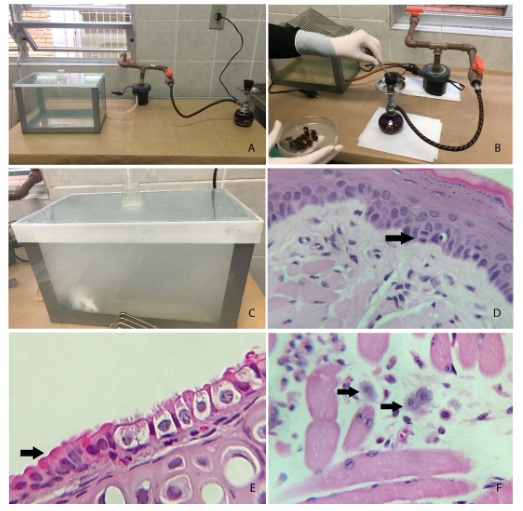
A New Adapted Machine to Simulate Narghile Smoke
*Corresponding Author(s):
Pilati SFMUniversity Of Itajaí Valley, Santa Catarina, Brazil
Tel:+55 4837216132,
Fax:+55 4837216132
Email:sarahfreygang@gmail.com
Abstract
As only few studies, to date, have reported new methodologies to simulate the flow of human puff topography during the use of water-pipes, we present - based on an existing machine produced with a high financial investment - a new low-cost simplified device to submit mice to water-pipe smoke, supporting the accomplishment of new scientific research with affordable costs.
INTRODUCTION
In animal exposure experiments, researchers look for a better way to simulate the same conditions of human exposure. For instance, to evaluate the effects of cigarettes in human tissues and systems, some machines were created to mimic topography of the human flow [1]. However, these machines have a high financial investment and are not suitable for narghiles, a device that has become popular worldwide, especially among young people [2]. It has been proven that narghile smoke presents a high amount of toxicants and carcinogens, however, the false belief that it is not so harmful as cigarettes and the lack of government control strategies contributed for a fast spread of the use [3,4].
As only few studies have reported new methodologies to simulate breath topography during the use of narghile, we have developed, based on an existing machine with high financial invest, a new low-cost dispositive to submit mice to narghile smoke, supporting the accomplishment of new scientific researches with affordable budget [5]. In this short communication we would like to present a low-cost device to submit mice to narghile smoke.
We confirm that all procedures performed with the animals were in accordance with the ethical standards of the institution which the studies were conducted: Itajaí Valley University, Itajaí, and Santa Catarina, Brazil – permission number 063/17.
For the experiment, a chamber was constructed with a glass lid sealed with silicone and with a 4mm diameter orifice for allocating a silicone hose. The glass chamber was connected to an electrical suction machine with a manual flow control which is attached to the narghile apparatus (Figures 1(A, B and C)). The animals were exposed to one flow of smoke for 2 two seconds, interspersed with 58 seconds of fresh air, totalizing a session of 30 minutes. The time of exposure was based on a recently published study that evaluated cardiorespiratory effects of narghile smoke in humans [6]. One flow of smoke, according to Beirut method, equals to 530 ml of smoke, so the cumulative total smoke per session was 15.900 ml per session. According to the literature is the average that a human being aspires in a session [5,6-8]. It is assumed that within this period, the difference in quantity of smoke applied to each animal inside the chamber was negligible. The electric suction machine was adjusted to result a total volume of 530 ml as Beirut method preconizes. Using this type of system, it is possible to work with more or less animals; however, it would be necessary to recalculate the volume of smoke according to the chamber size and methodology used.
 Figure 1: A: Device; B: Device in operation; C: Sealed chamber with smoke; D: Histological section of tongue showing the presence of mitosis (arrow) in the epithelium; E: Histological section of trachea showing squamous metaplasia (arrow) in the respiratory epithelium; F: Inflammatory cells in the connective tissue and between the muscle fibers.
Figure 1: A: Device; B: Device in operation; C: Sealed chamber with smoke; D: Histological section of tongue showing the presence of mitosis (arrow) in the epithelium; E: Histological section of trachea showing squamous metaplasia (arrow) in the respiratory epithelium; F: Inflammatory cells in the connective tissue and between the muscle fibers.
An important aspect of using a whole-body exposure system in animals exposed to water-pipe smoke is that there are several methodologies which can be developed according to the objective of the study. Examples of possible future research include: hemogram analysis evaluating nicotine doses; presence of carbon monoxide; identification of multiple toxins and carcinogens that may be present in the bloodstream as a result of waterpipe smoke exposure. Furthermore, clinical and histological evaluation of organs (such as tongue, trachea, esophagus, lung and liver) and cardiorespiratory effects are other aspects that may be possibly considered for analysis in animals.
This type of system enables the use of a bigger or smaller number of animals; however, we reinforce that smoke volume has to be recalculated according to chamber size for more precise results and a closer approach to simulate the flow of human puff topography. The development of new methodologies with affordable costs may lead to increased research activity and advance the knowledge of health professionals. This way, they can alert the population about the dangers that harmful habits may cause and comply with government regulations regarding this type of smoking devices.
REFERENCES
- de Oliveira Semenzati G, de Souza Salgado B, Rocha NS, Michelin Matheus SM, de Carvalho LR, et al. (2012) Histological and immunohistochemical study of the expression of p53 and ki-67 proteins in the mucosa of the tongue, pharynx and larynx of rats exposed to cigarette smoke. Inhal Toxicol 24: 723-731.
- Maziak W, Taleb ZB, Bahelah R, Islam F, Jaber R, et al. (2015) The global epidemiology of waterpipe smoking. Tob Control 24: 3-12.
- Walters MS, Salit J, Ju JH, Staudt MR, Kaner RJ, et al. (2017) Waterpipe smoking induces epigenetic changes in the small airway epithelium. PLoS ONE 12:
- El-Zaatari ZM, Chami HA, Zaatari GS (2015) Health effects associated with waterpipe smoking. Tobacco Control 24: 31-43.
- Katurji M, Daher N, Sheheitli H, Saleh R, Shihadeh A (2010) Direct measurement of toxicants inhaled by water pipe users in the natural environment using a real-time in situ sampling technique. Inhal Toxicol 22: 1101-1109.
- Nemmar A, Hemeiri AA, Hammadi NA, Yuvaraju P, Beegam S, et al. (2015) Early pulmonary events of nose-only water pipe (shisha) smoking exposure in mice. Physiological Reports 3: 12258.
- Khabour OF, Alzoubi KH, Bani-Ahmad M, Dodin A, Eissenberg T, et al. (2012) Acute exposure to waterpipe tobacco smoke induces changes in the oxidative and inflammatory markers in mouse lung. Inhal Toxicol 24: 667-675.
- Shihadeh A, Azar S, Antonios C, Haddad A (2004) Towards a topographical model of narghile water-pipe café smoking: a pilot study in a high socioeconomic status neighborhood of Beirut, Lebanon. Pharmacol Biochem Behav 79: 75-82.
Citation: Flausino CS, Hoffmeister GF, Pilati PVF, Modolo F, Pilati SFM (2020) A New Adapted Machine to Simulate Narghile Smoke. J Cytol Tissue Biol 7: 029.
Copyright: © 2020 Flausino CS, et al. This is an open-access article distributed under the terms of the Creative Commons Attribution License, which permits unrestricted use, distribution, and reproduction in any medium, provided the original author and source are credited.

